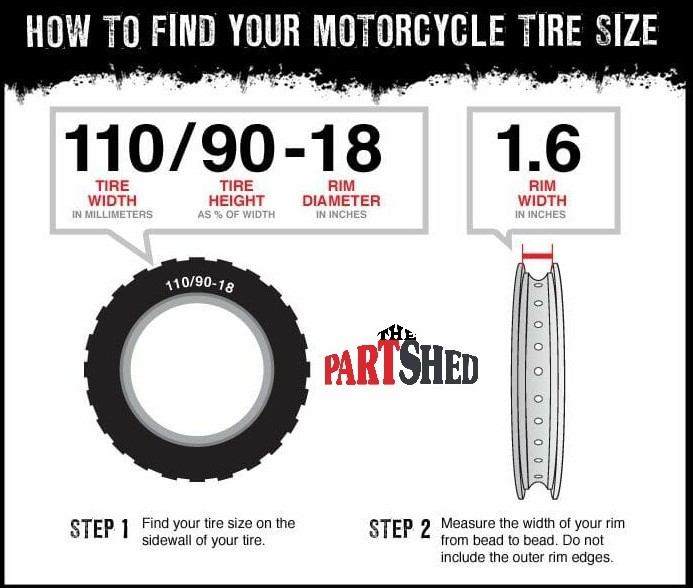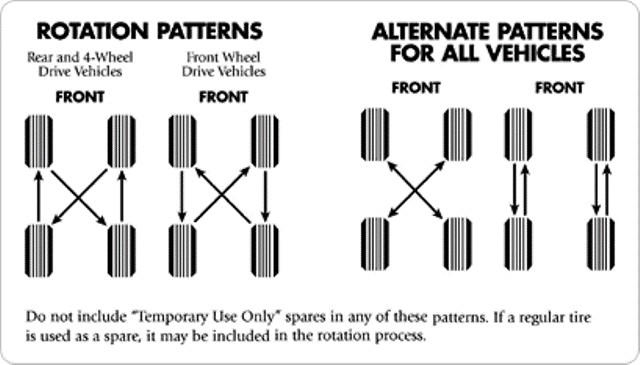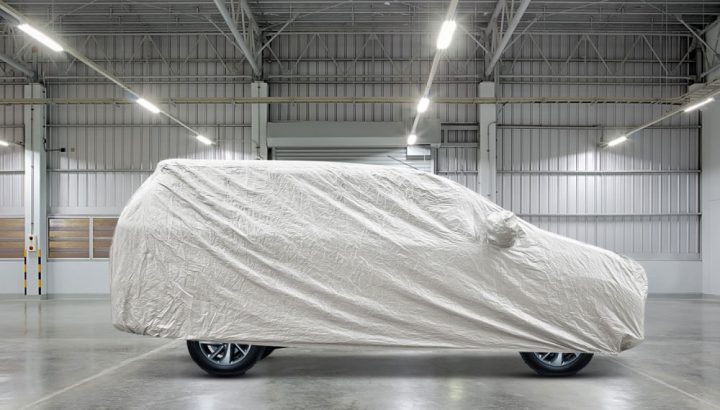If you have a flat tire, you know how frustrating a process it is to get your car back to its normal operation. Not only does it disrupt your travel, it also takes time and money to replace a flat. After you change the flat tire and install your spare, you might be wondering: how long can you drive on it?
In this article, we’ll tell you just how far you can drive on a spare tire, what the key differences in types of spare tires are, and best practices for driving on a spare tire.
Let’s jump right in by answering your main question:
You should drive no more than 50 miles on a temporary or donut spare tire if possible. If you absolutely must go longer than 50 miles, avoid driving on it longer than 70 miles. A spare tire isn’t meant to completely replace a tire, rather, its purpose is to tide you over until you can properly replace it.
Additionally, you shouldn’t drive faster than 50 mph on a temporary or donut spare tire, as they have far less traction and durability than a standard tire. You probably wouldn’t want to drive longer or faster on a spare anyway, as the typical spare can make your vehicle feel more like an airplane ambling down a runway than a car driving down a highway.
Once you are driving your spare, you should replace it with a proper full-size tire as quickly as possible to stay safe on the roads.
Types of Spare Tires:There are several kinds of spare tires, but which one you will use mostly depends on the type of vehicle you’re driving.
 These vehicles are significantly heavier than most sedans and mid-sized cars, so the spare tires are usually larger to support the vehicle’s full load, and possibly additional cargo or items being towed.
These vehicles are significantly heavier than most sedans and mid-sized cars, so the spare tires are usually larger to support the vehicle’s full load, and possibly additional cargo or items being towed.Full-size spares are typically much better quality than a donut spare; however, they still should be replaced as soon as possible. These spares often aren’t as durable, may have narrower wheels than the standard tires, and may not be produced by the same manufacturer as your other tires.
Full-size spare tires should be regularly inspected too, especially if they are secured to the bottom of the vehicle and therefore may be exposed to harsher elements.
How to drive safely on a spare tireRegardless of whether your spare is a donut or a full-size spare, you’ll want to be careful while driving on it. To drive safely on your spare tire, follow these best practices:
 Spare tires often have different inflation pressure needs than your regular tires, so it’s wise to check them for proper inflation. Plus, a spare tire isn’t much help if it has low pressure.
Spare tires often have different inflation pressure needs than your regular tires, so it’s wise to check them for proper inflation. Plus, a spare tire isn’t much help if it has low pressure. Many spare tires have a lifetime of about eight years.
Many spare tires have a lifetime of about eight years.As the Midwest’s premier driving school, Top Driver takes pride in preparing our students for everything they encounter on the road and with their vehicle.
With more than 40 locations throughout Illinois, Michigan, and Ohio, Top Driver is your best resource for driver education. Each year we provide countless hours of in-vehicle training and classes, not to mention our free blog covering best practices for road safety. If you’re looking for teen programs for new drivers, adult, or remedial courses, Top Driver has you covered.
We’re also going the extra mile to ensure a safe learning space for our students and instructors by providing remote classroom education opportunities and implementing a coronavirus vehicle sanitization process.
Call 1 (800) 374-8373 or enroll online today!
Editor’s Note: This blog has been updated in 2021 to reflect current industry standards.
In older cars, every model came with a spare tire that matched the tires already on the vehicle. Over the years, car manufacturers have realized the spare tire is used so infrequently, it does not make much sense to equip every car with a full-sized spare. For this reason, manufacturers began leaving a space-saver spare (otherwise known as a donut) in place of a full-size spare.
Nowadays, spare tires should never be a permanent replacement, begging the question, how long can you really drive on a spare tire? The type of spare tire in your vehicle makes a difference in how long and how far you can drive before fixing your tire or buying a new tire.
These narrow, compact spares are designed to save space and weight in the vehicle, allowing the manufacturers to build a smaller car. However, the tire itself is not built to last. Your owner’s manual will give recommendations for driving time and speed. A general rule of thumb is to drive no farther than 70 miles and no faster than 50 miles per hour before replacing your donut with a new tire.
The biggest reason why you should avoid prolonged use of space-saver or donut tires is that they have little to no tread, making the spare vulnerable to road hazards and projectiles. It is also much smaller than the other 3 tires, making it spin faster to keep up with the moving car.
Run-flat tires are becoming more common as manufacturers realize they cost less to maintain than traditional tires. If you drive a recent model BMW or a MINI, your car likely came with run-flat tires. These tires are tougher than most tires but are not designed to last forever, such as a full-spare tire.
Rather than including a spare tire, these run-flat tires are built to withstand most road hazards, including punctures. Rather than going flat or blowing out (as traditional tires do), a run-flat tire can continue to drive after punctured for about 50 miles before needing to be replaced. However, these tires cost more to replace than traditional tires.
While you have a bit more room to travel on these types of tires, it is important to inspect your tire as soon as you are aware of any change in tire pressure. This gives you an idea of how long you have until you have no choice but to have your tire replaced.
This gives you an idea of how long you have until you have no choice but to have your tire replaced.
How Long Can You Drive on a Full-Size Spare Tire?
For years, cars were built with spare tire wells capable of carrying a full-size spare. On many older cars (and a few newer models), this is still the case. If you bought a truck, SUV, or another large vehicle, your car probably is equipped with a full-size spare. While a full-size spare is heavier and requires a larger space for storage, these tires are more durable and can handle a drive similar to a regular tire.
Once you have taken your vehicle to an auto repair shop and learned that the punctured tire is irreparable, you can request the spare tire to be put on the original rim.It is important to note that a full-size spare tire is usually not produced by the same manufacturer as the rest of the tires on your vehicle, meaning it will handle differently than the other tires. We suggest buying a new tire as soon as you can afford to, but this can easily buy you some time.
Christian Brothers Automotive was born out of the idea of not just being an auto repair shop, but also a neighbor. Our mission is simple: to take root in the local communities we serve and to create an uncommonly great experience for customers in need of auto service and repair. To have your tires inspected or to replace a spare tire, please do not hesitate to call or visit your local Christian Brothers Automotive shop. We have 240 plus locations nationwide that are locally owned and operated, providing complete auto care and repair solutions near you.
Temporary splinting is a method that is used in the treatment of periodontitis to reduce the functional overload of the teeth, and consists in connecting the teeth to each other with a special structure (tire) that has a certain rigidity. The splint limits the movement of the teeth: they can only move together with the structure holding them, which is practically impossible. This immobility of the teeth has a beneficial effect on periodontal tissues. Today, inorganic fiberglass is mainly used for splinting, which has excellent moisture resistance and biocompatibility with human tissues. nine0003
This immobility of the teeth has a beneficial effect on periodontal tissues. Today, inorganic fiberglass is mainly used for splinting, which has excellent moisture resistance and biocompatibility with human tissues. nine0003
Splinting is a therapeutic method used in the treatment of periodontitis in order to reduce the functional overload of the teeth. Splinted, that is, interconnected teeth, acquire stability and almost completely restore chewing ability. Splinting of teeth has a beneficial effect on the condition of periodontal tissues - purulent discharge from periodontal pockets stops, puffiness is removed, and blood supply to the gums improves. In addition, the destruction (resorption) of the bone tissue of the jaw slows down or stops altogether. The general well-being of a patient suffering from periodontitis also improves: after splinting of the teeth, tension, itching and a feeling of fullness in the oral cavity disappear, as well as headaches that often accompany pathology. nine0003
nine0003
Permanent or temporary splinting is carried out at all stages of periodontitis, but more effective treatment should be expected from treatment started at the first sign of periodontal tissue overload. In dentistry, different types of splinting are used. The design is selected taking into account the individual characteristics of the patient, it should provide a therapeutic effect and not violate, but, if possible, restore the aesthetics of the dentition. Currently, for temporary splinting of teeth after therapeutic treatment of periodontitis, fiberglass and light-cured composites, as well as orthodontic splinting with a ligature, are most often used. nine0003
A splint is a structure that has a certain rigidity, the therapeutic effect of which is based on the laws of biomechanics. The tire limits the movement of the teeth - they can only move together with the structure holding them, which is almost impossible. In addition, the splint "quenches" the amplitude of the natural oscillations of the teeth, since its own amplitude of oscillations is negligible.
The immobility of the teeth provided by the splint has a beneficial effect on periodontal tissues. Interestingly, the more teeth with a relatively healthy periodontium are included in the splint, the more obvious the effect of its use: the masticatory load primarily falls on healthier tissues, and pathologically altered ones, thus, are unloaded and have the opportunity to recover. A greater effect should be expected from a splint that connects a sufficiently large group of teeth. The most rigid is the arc-shaped design, since its shape ensures the mutual intersection of the mobility vectors of the teeth being held. nine0003
 nine0006
nine0006 The only contraindication to temporary splinting of teeth is the unsatisfactory condition of the oral cavity, that is, the presence of caries and abundant dental deposits. The contraindication is not absolute - after the sanitation of the oral cavity and periodontal cleaning of the teeth, the splint can be installed.
For temporary splinting of teeth, as an option, modern fiber reinforcing materials, light-curing polymers and adhesive systems with high adhesion to tooth tissues are used. The dentists of our clinic prefer Swiss and American inorganic fiberglass. This material has excellent moisture resistance (practically does not absorb moisture) and is completely biocompatible with human tissues. nine0003
 The dentist draws up a treatment plan, which includes drug therapy for periodontitis, and possibly surgical treatment - flap surgery, band plastic surgery, etc.
The dentist draws up a treatment plan, which includes drug therapy for periodontitis, and possibly surgical treatment - flap surgery, band plastic surgery, etc.  The dentist grinds and then polishes the tire with special nozzles.
The dentist grinds and then polishes the tire with special nozzles. In terms of time, splinting of teeth takes 1-2 hours, usually one visit to the dentist is enough for the procedure, but in difficult cases an additional visit to the doctor may be required.
Tires made of fiberglass tape and composite material are considered temporary (usually they are put on for 1-2 years), but they last quite a long time: according to statistics, in 95% of patients, they, if necessary, last from 3 to 5 years without replacing the reinforcing tape. Although it is rarely possible to do without additional grinding, polishing and renewal of the composite material, so you need to regularly (at least 1 time in 6 months) see the dentist for design correction and professional hygienic cleaning of your teeth. If the fiberglass splint is broken, you should contact a specialist without waiting for the splinted teeth to separate. In most cases, it is not necessary to remove the entire structure - with the help of modern adhesive materials, a new piece of reinforcement is easily connected to the main part of the fiberglass tape. nine0003
nine0003
According to the observations of specialists, temporary splinting of teeth in many cases allows achieving a stable remission and helps to save teeth only with careful oral care. Splinting with fiberglass thread is a painless procedure, but after it there is discomfort associated with the appearance of a new “object” in the oral cavity. Practice shows that patients get used to the tire quickly, and the ability to chew food normally compensates for all the inconvenience. Unfortunately, the presence of a tooth-holding structure does not allow the use of floss (floss) for cleaning interdental spaces, but there is an alternative to it - brushes and irrigators, so that, if desired, high-quality care for splinted teeth can be provided at home. nine0003
 Highly qualified specialists will restore the integrity of the dentition, restore the functionality of the teeth and the aesthetic appearance of the smile.
Highly qualified specialists will restore the integrity of the dentition, restore the functionality of the teeth and the aesthetic appearance of the smile.  An individual set of disposable consumables (gloves, rubber dam, saliva ejector, mask, etc.) is prepared for each client. Reusable instruments are carefully sterilized (the latest sterilization equipment is installed in our clinic), so temporary splinting of teeth and other dental procedures performed at GrandMed are absolutely safe for patients. nine0006
An individual set of disposable consumables (gloves, rubber dam, saliva ejector, mask, etc.) is prepared for each client. Reusable instruments are carefully sterilized (the latest sterilization equipment is installed in our clinic), so temporary splinting of teeth and other dental procedures performed at GrandMed are absolutely safe for patients. nine0006 There are many methods for making temporary tires, and the list of materials for their manufacture is quite impressive: these are fiberglass, composites, metal alloys. However, all such structures are designed for the same purpose - to turn the teeth into single blocks for even distribution of the load during chewing. Therefore, the following requirements apply to all dental splints:
However, all such structures are designed for the same purpose - to turn the teeth into single blocks for even distribution of the load during chewing. Therefore, the following requirements apply to all dental splints:

Temporary splints are installed, as a rule, for the period of treatment of periodontitis, and it, depending on the severity of the disease, can be different - from several months to two or more years. Since it is almost impossible to completely get rid of the changes that have occurred in the periodontal tissues due to inflammation, in most cases in the future there is a need for permanent splinting. Splinting types of bridge structures are best suited for this purpose. nine0003
A temporary tire made of fiberglass material is permanently in the oral cavity - it is impossible to remove it yourself. But in some cases, for example: refusal of preparation (removal of hard tissues when creating a splint bed), the patient is offered to install a removable splint (splinting mouth guard) or a fixed structure (orthodontic retainer).
There may be several indications for the procedure, but splinting for periodontitis is most in demand.
Help! Periodontitis is an inflammatory disease of periodontal tissues (tissues that surround the tooth and serve as its support). Periodontitis is characterized by an asymptomatic course, which is the reason for a late visit to the doctor, when the soft and bone tissue is already thoroughly destroyed and the tooth simply has nothing to hold on to. nine0138
In the later stages of periodontitis, the subgingival part of the tooth is exposed by ¼ or more. In this case, it is necessary to urgently treat periodontitis and perform splinting of mobile teeth .
Also splinting of teeth is performed in such cases:

Constructions for performing splinting are diverse and differ depending on the problem being solved and the long-term therapy.
The teeth are connected into a single block using a rigid fastening structure - a splint, which can be either stationary or removable. Any tire must meet the following requirements: nine0003
It is important that during splinting, more healthy teeth get into the coverage area of the structure - this will relieve bad teeth and give them a "rest". If the entire dentition is mobile, the splinting procedure will be less effective. nine0003
nine0003
Since the tire makes it possible to distribute the chewing load, the more units of the dentition will be involved in it, the more effective the therapy will be. The most effective splinting of the front teeth. When installing a splint on molars and premolars (on the sides), splinting of the teeth is performed symmetrically on both sides, and then connected with a bridge. This is necessary for additional reinforcement, since the linear structure is much less stable than the arched one.
According to the duration of wearing tires are divided into 3 types: nine0003
The type of bus and the duration of its use depends on the task that this system solves at this stage.
For example, tooth splinting for periodontitis is performed as part of the treatment of this disease. And this means that the state of the dentition can change, both for the better and for the worse. For example, the loss of one or more teeth in periodontitis is not uncommon. After that, it is necessary to change the shape of the structure, taking into account the missing units. Therefore, during the period of intensive treatment, temporary splints are usually used. nine0003
For example, the loss of one or more teeth in periodontitis is not uncommon. After that, it is necessary to change the shape of the structure, taking into account the missing units. Therefore, during the period of intensive treatment, temporary splints are usually used. nine0003
Temporary structures must:
Permanent splints are needed as maintenance therapy.
To these are added the requirements of aesthetics and high wear resistance. However, periodontal diseases are characterized by relapses, therefore, even when using a permanent structure, it is desirable to be able to modify it. nine0003
Long-term systems are a kind of compromise between a temporary and a permanent bus. They are installed if remission is achieved, but there are doubts about its durability. Splinting of teeth can be performed:

Temporary and long-term splinting is usually performed with threads, and permanent splinting with prostheses. nine0003
Which of the methods will be used and what materials are chosen, the doctor decides, depending on the individual characteristics of the patient and the treatment plan. When splinting threads, fiberglass, polyethylene, aramid fiber are actively used. The structure of all threads is similar - it is weaving from fibers with a thickness of 3 to 5 microns. However, their chemical composition is different, and therefore the properties differ.

Consider the procedure for performing the procedure using a fiberglass thread. When splinted with threads from other materials, it is almost the same, and differs only in small nuances.
Splinting of teeth with fiberglass is carried out in several stages:
 Before this, the patient is given an injection of local anesthetic.
Before this, the patient is given an injection of local anesthetic. Thus, a beam structure is obtained, which reliably eliminates tooth mobility, has excellent aesthetics, does not affect diction and does not interfere with oral care. nine0003
Splinting with fiberglass tape is currently one of the most popular methods for this procedure.
Before performing splinting of mobile teeth with fiberglass, the doctor can refer the patient to remineralization - saturation of tooth enamel with microelements. This will make it possible to prevent increased sensitivity of the teeth after the installation of the structure. After removing the tire, the cuts are subject to sealing.
In this method, aramid thread is used. This is a material of increased strength, which makes it possible to perform cable-stayed splinting of teeth not only for temporary, but also for long-term use.
This is a material of increased strength, which makes it possible to perform cable-stayed splinting of teeth not only for temporary, but also for long-term use.
Help . The word aramid means "aromatic polyamide". The intricately interwoven structure of the fibers gives the fabric unique strength, wear-resistant and heat-resistant properties. Aramid products are used in the production of overalls for the police, army, firefighters. Kevlar is a brand name for bulletproof helmets and body armor made from aramid. nine0138
This type of splinting is similar to fiberglass splinting in terms of the method of execution - a horizontal cut is made on the teeth, on which an aramid tape is applied. Then it is closed with a filling composite material. This method can also be used for dental prosthetics - the prosthesis is securely fastened with aramid thread between healthy teeth.
Since periodontal diseases, in most cases, are accompanied by defects in the crown (the visible part of the tooth) and loss of teeth, there is a need for prostheses with a splinting property. The clasp design can not only fix diseased teeth, but also replace already lost ones - that is, be essentially a prosthesis splint. nine0003
The clasp design can not only fix diseased teeth, but also replace already lost ones - that is, be essentially a prosthesis splint. nine0003
A clasp prosthesis is a removable structure that consists of a frame that is held in the jaw with locks or clasps. The frame is an arc (byugel) of links in the form of claw-like processes or clasps. The clasp is attached to healthy teeth, on which crowns are put on.
Construction steps:
The method has disadvantages - this is a high price, rather low aesthetics of the clasp with clasps, the need for the patient to have at least 4 supporting teeth (otherwise the structure cannot be installed).
The inlay splint is a metal arc mounted on a specially prepared cutting edge. The structure is attached to crowns or pins, which are placed on the abutment teeth. The manufacture of such a structure is quite difficult technically. Crown teeth require preparation. This type of splinting is usually performed on the front teeth. nine0003
Brazed metal or non-metal crowns can also serve as a splint. However, under them, the preparation of teeth is necessary - most often, this is not advisable from a medical point of view. Aesthetically made crowns made of metal-ceramic, porcelain or zirconium are expensive - and this is already unjustified from the material side.
With fiberglass and cable-stayed splinting, the following unpleasant consequences are possible: nine0003

There are few contraindications for the procedure. An absolute contraindication is an allergy to the materials used. Relative - increased sensitivity of the teeth, severe inflammation of the gums, purulent processes inside the gum pockets. These factors must be eliminated before splinting. With poor oral hygiene, the installation of a splint may simply be useless. nine0003
The cost of the procedure depends on the chosen technique and materials.